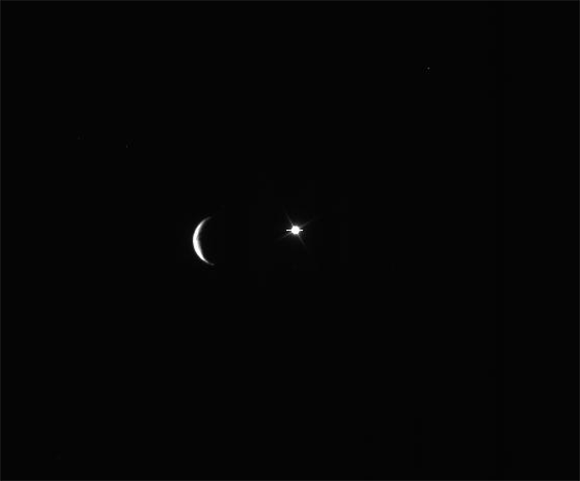It’s a cosmic cover-up! No, don’t put your tinfoil* hats on, this isn’t a conspiracy — it’s just Saturn’s moon Iapetus drifting in front of the bright star Gamma Orionis (aka Bellatrix) captured on Cassini’s narrow-angle camera on August 10, 2013.
Such an event is called an occultation, a term used in astronomy whenever light from one object is blocked by another — specifically when something visually larger moves in front of something apparently smaller. (The word occult means to hide or conceal… nothing mystical implied!)
The animation above was assembled from 19 raw images publicly available on the JPL Cassini mission site, stacked in Photoshop and exported as a gif. They’ve been rotated 90º from the originals but otherwise they’re right from Cassini’s camera.
Iapetus, seen above as just a thin crescent, is best known for its two-toned appearance. One half of the 914-mile-wide moon is bright and icy, the other coated with a layer of dark reddish material, giving it a real “yin-yang” appearance. (Ok, I guess that’s a little mystical. But purely coincidental.)

It’s thought that the dark material originates from a more distant moon, Phoebe, which is being pelted by micrometeorites and shedding its surface out into orbit around Saturn, which eventually gets scooped up by the backwards-orbiting Iapetus.
The difference in albedo affects how Iapetus absorbs solar radiation too, causing the water ice beneath the darker material to evaporate over the course of its 79-Earth-day rotation and migrate around its surface, creating a sort of positive feedback loop.
While neat to look at, occultations are important to science because they provide a way to briefly peer into a world’s atmosphere (or in a small moon’s case, exosphere). Watching how light behaves as it passes behind the limb of a planet or moon lets researchers learn details of the air around it — however tenuous — pretty much for free… no probes or flybys needed!
The occulted star above is Bellatrix, the 1.6-magnitude star that marks Orion’s left shoulder.
Iapetus orbits Saturn at the considerable distance of 2,212,889 miles (3,561,300 km). Learn more about Iapetus here, and as always you can find more fantastic Cassini images from Carolyn Porco’s team at the Space Science Institute in Boulder, Colorado at the CICLOPS site here.
______________________
*Do they still make foil out of tin any more?


Cosmic Pac-Man….